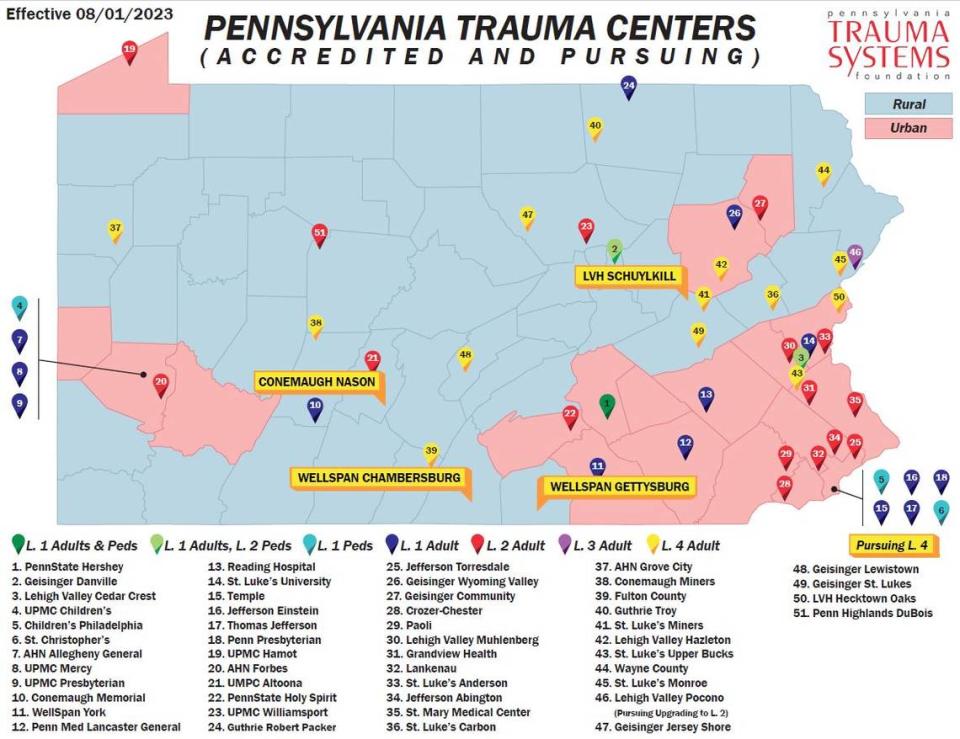How far away is a trauma center from State College? One of the farthest distances in PA
Early plans are seemingly in place to bring a trauma center to the State College area and fulfill one of Centre County’s major health care needs.
Officials at Mount Nittany Health are optimistic about preliminary plans to develop a trauma center, which could help Mount Nittany Medical Center provide specialized care for people who have sustained traumatic and life-threatening injuries, often the result of car crashes, falls and other accidents. Today, there are no trauma centers in Centre County, though a few are available in neighboring counties if patients can survive — and pay for — an emergency drive or airlift often dozens of miles long.
As one of the most populated areas in Pennsylvania, State College and the Centre Region at large remain in need of a trauma center. That importance becomes far clearer when taking a broader look at trauma center access in Pennsylvania.
Where are the closest trauma centers to State College?
Though Mount Nittany Medical Center sits roughly 3.3 miles from the State College borough, no accredited trauma centers are nearby.
The closest trauma center of any sort is Geisinger Lewistown, which is roughly a 31-mile drive from State College to Mifflin County to the south. The hospital is classified as a Level IV trauma center, meaning it is smaller in size and primarily provides initial care and stabilization for traumatic injuries before arranging patient transfer to a higher-level trauma center, according to the Pennsylvania Trauma Systems Foundation, the commonwealth’s certifying body that oversees accreditation.

More than 500 Centre County patients are flown to nearby health facilities every year. Their most common destinations are UPMC Altoona (Level II) and Geisinger Danville (Level I), which are equipped to treat nearly any traumatic affliction. The facilities in Altoona and Danville are respectively about 45- and 85-mile drives from State College.
For now, Mount Nittany Health plans to pursue Level IV trauma center accreditation for its Mount Nittany Medical Center facility. While such a unit would help local patients treat serious injuries, many would still require eventual transfers to other, higher-level trauma centers in nearby counties.
Putting Pennsylvania in perspective
Today, State College is farther away from an accredited trauma center than any incorporated place in Pennsylvania with a larger population, according to recent U.S. Census Bureau estimates.
Only 12 incorporated places in Pennsylvania have a larger population than State College’s estimate as of July 2022, U.S. Census data reads. State College checks in with a population of 40,745 people, falling just behind Wilkes-Barre (44,261) and Altoona (43,071). Philadelphia leads the pack with an estimated population of roughly 1.57 million people, far exceeding Pittsburgh’s estimated population of 302,898 people.
Despite their differences in size, all 12 incorporated places larger than State College are closer to trauma centers. Major cities like Philadelphia and Pittsburgh each have a handful of accredited facilities within their limits, while others throughout the Keystone State — including Allentown, Reading, Erie and Scranton — have options within a few miles.
Wilkes-Barre has the largest distance from a trauma center among the dozen incorporated places with larger populations than State College, according to the Pennsylvania Trauma Systems Foundation. Still, the drive from Luzerne County’s premier city to nearby Geisinger Wyoming Valley Medical Center — a Level I trauma center — is about 5 miles.
A lack of trauma center access is a particularly large concern in Centre County due to Penn State’s University Park campus, with an enrollment exceeding 40,000 students. Thanks to its roughly 31-mile drive to a trauma center, the Penn State campus is the farthest away from a facility among Pennsylvania’s four “state-related” universities, which are not state-operated but receive appropriations from the commonwealth. State-related schools like the University of Pittsburgh and Temple University are in close proximity to trauma centers in Pittsburgh and Philadelphia, respectively, while Lincoln University — located near Oxford, in southeastern Pennsylvania — is about 25 miles away from trauma centers in Wilmington, Delaware.
Penn State’s University Park campus is also farther away from a trauma center than any of its peers in the Big Ten conference. Maryland (11 miles) and Purdue (5 miles) have some of the lengthier drives to nearby trauma centers, while six schools offer trauma centers located immediately on their main campuses.
What’s next for Centre County?
Though plans remain in early stages, Mount Nittany Health will need to pursue formal accreditation to launch a certified trauma center. Officials from the Pennsylvania Trauma Systems Foundation, the commonwealth’s certifying body, say that process could take more than two years.
Until trauma center services are offered in Centre County, residents who suffer severe injuries will continue receiving transfers to facilities in neighboring counties through costly airlifts and ambulance rides that may vary in length and duration due to weather and distance.
A 2019 report from the U.S. Government Accountability Office found the median price charged by airlift providers was roughly $36,400 for one-way helicopter transport, and that bill could remain hefty if the airlift provider is not in the patient’s insurance provider’s network.

